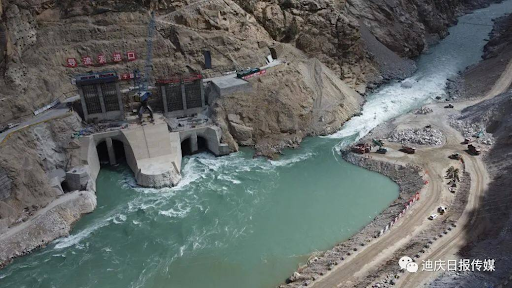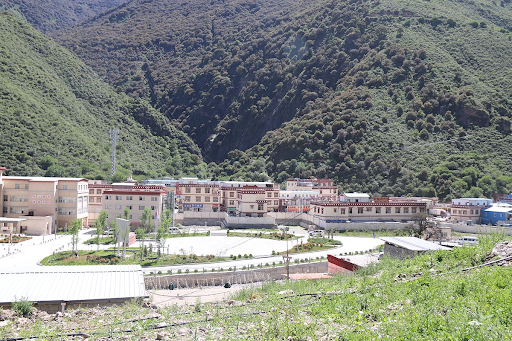The Chinese authorities are forcibly constructing hydropower dams in the upper reaches of the Drichu (Ch: Jinsha) river, leading to the involuntary relocation and displacement of local Tibetans from their ancestral villages and centuries-old Tibetan Buddhist monasteries. These large-scale dams are constructed in alignment with the objectives of the ‘West-East Electricity Transmission’ project. The electricity these dams produce will ultimately supply power to industrial cities in eastern China.
On the fifth day of the Tibetan New Year, 14 February, hundreds of Tibetans, including laypersons and monks, gathered in Derge (Ch: Dege) County to peacefully appeal to the local Chinese authorities against the forced relocation. This dam project will result in the devastating displacement of at least six monasteries, including Yena Monastery, Wontoe Monastery, Khadho Monastery, Rabten Monastery, Gonsar Monastery, and Tashi Monastery, as well as the villages of Wontoe and Shepa, situated near the Yangtze River in Derge (Ch: Dege) and Jomda (Ch: Jiangda) County. Sources with contacts in the area told TCHRD that the authorities did not consult local Tibetans or obtain their informed consent before implementing the project.

The decision to announce the relocation of Tibetans was deliberately chosen to align with the Tibetan New Year, strategically aimed at diverting public attention and minimising potential unrest. Local authorities deployed a large number of security forces, including police officers, at the site of the protest to intimidate, suppress and arrest Tibetans in Wontoe Township and Derge County. Many monks and residents from Wontoe and Yena Monastery were detained. They faced harsh measures, including the use of water bullets and electric weapons, resulting in injuries that necessitated hospitalisation for many. Since then, more than one thousand Tibetans have been detained and left without adequate food and clothing. Furthermore, the Chinese authorities blocked the internet and censored information related to the protest from social media platforms as part of the widespread security clampdown in the area.

When practically implemented through a statist, top-down model, the Chinese development model is inconsiderate of, and as a result, damaging to, the collective rights of the already marginalised and disempowered groups. In addition to the complete disruption of the livelihood of the local Tibetans, the culturally significant heritage walls, paintings, and murals will also suffer considerable harm. Both Wontoe Monastery and Yena Monastery in Derge County, currently facing the imminent threat of relocation, harbour a plethora of age-old Tibetan cultural artefacts of historical significance dating back to the 14th century.
West-East Electricity Transmission Project Destroys Tibetan Way of Life
As per China’s 14th Five-Year Plan (2021-2025), numerous hydropower station initiatives are continuously outlined for Tibetan rivers, including the Yarlung Tsangpo, the Drichu (Ch: Jinsha), and the Dzachu (Ch: Mekong). In 2020, reports indicated an investment of approximately 221.42 billion yuan (equivalent to 3.075 billion US dollars) in a newly proposed hydropower project in the upper reaches of the Drichu (Ch: Jinsha) river within Tibet Autonomous Region only. Furthermore, in 2019, the Tibet Autonomous Region purportedly contributed over 1.6 billion kilowatt-hours of electricity to China, establishing itself as a pivotal hub for the execution of the ‘West-East Electricity Transmission’ project. Additionally, expansive reservoirs are under construction in Tibetan regions and have been assimilated into Sichuan and Yunnan provinces as part of the larger West-East Electricity Transmission project framework.

The dam projects along the upper reaches of the Drichu (Ch: Jinsha) are being constructed and implemented in collaboration with Chinese state-owned energy companies. These include CHN Energy Investment Group (CHN Energy) as the supervisor and the government-affiliated power companies China Huadian Corp and its subsidiary Huadian Jinsha River Upstream Hydropower Development Co.Ltd.
Numerous dams have been built and continue to be constructed on this stretch of the Drichu (Ch: Jinsha). Currently, at least 13 hydropower stations exist solely in the upper reaches of the Drichu on Tibetan land. Six of these are massive dams with a power generation capacity exceeding a million kilowatts. Additionally, several of these dams are relatively new, with construction initiated during the COVID-19 pandemic and currently ongoing.
Once displaced, Tibetans are resettled in unfamiliar urban areas, where these villages undergo stringent control and surveillance, as the CCP views Tibetans, including dissenters and protesters, to the enforced government initiatives as potential sources of unrest. Chinese authorities institute “Resident Committee Offices” and appoint permanent “village management personnel” who conduct continuous ideological indoctrination for the relocated Tibetans, employing tactics akin to forced “nighttime study sessions,” illustrating the comprehensive methods utilised to govern the relocated populace. Despite the unwillingness of the relocated individuals, they are compelled to acquire skills and participate in physical labour, such as working in newly established greenhouses or farms. Additionally, the government and employer confiscate a substantial portion of their earnings from these jobs, leaving them in a dire economic situation.

The Chinese government continues to forcibly displace thousands of Tibetans from their ancestral lands under the guise of environmental conservation. Simultaneously, they are accelerating the construction of new dams on Tibet’s major rivers like the Drichu (Ch: Jinsha), causing significant damage to the fragile natural environment and displacing thousands of Tibetans.
The Chinese government is fully aware of the fragile ecosystem along the course of Tibet’s rivers. Steep mountains and deep valleys characterise the upper reaches of the Drichu (Ch: Jinsha). In recent years, two significant landslides have blocked the flow of the Drichu River, displacing hundreds and putting them at risk. Moreover, in 2020, the upper Drichu region was declared the third most at-risk area for flooding in all of China.
“The Chinese government’s construction of large dams in areas known to be ecologically vulnerable, driven by purely economic motives, demonstrates a complete disregard for the safety of both Tibet’s environment and its people,” said Nyima Woeser, researcher at TCHRD. “The Chinese authorities must immediately halt the construction of mega hydropower dams in Tibet, without proper consultation or consent of the local population and stop the forced and coerced resettlement of Tibetans as echoed in the 2023 concluding observations by the UN Committee on Economic, Social, and Cultural Rights.”
